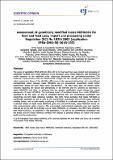Por favor, use este identificador para citar o enlazar a este item:
http://hdl.handle.net/10261/192121COMPARTIR / EXPORTAR:
 SHARE SHARE
 CORE
BASE CORE
BASE
|
|
| Visualizar otros formatos: MARC | Dublin Core | RDF | ORE | MODS | METS | DIDL | DATACITE | |

| Título: | Assessment of genetically modified maize MZHG0JG for food and feed uses, import and processing under Regulation (EC) No 1829/2003 (application EFSA-GMO-DE-2016-133) |
Autor: | EFSA Panel on Genetically Modified Organisms (GMO); Naegeli, Hanspeter; Bresson, Jean-Louis; Dalmay, Tamas; Dewhurst, Ian Crawford; Epstein, Michelle M.; Firbank, Leslie George; Guerche, Philippe; Hejatko, Jan; Moreno, F. Javier CSIC ORCID ; Mullins, Ewen; Nogué, Fabien; Rostoks, Nils; Sánchez Serrano, Jose Juan; Savoini, Giovanni; Veromann, Eve; Veronesi, Fabio; Devos, Yann; Ardizzone, Michele; Neri, Franco Maria; Papadopoulou, Nikoletta; De Sanctis, Giacomo; Fernandez Dumont, Antonio; Gennaro, Andrea; Gómez-Ruiz, José Ángel CSIC; Paraskevopoulos, Konstantinos | Palabras clave: | Maize (Zea mays) Regulation (EC) No 1829/2003 Herbicide tolerance GMO MZHG0JG |
Fecha de publicación: | 2018 | Editor: | John Wiley & Sons | Citación: | EFSA Journal 16(11): 5469 (2018) | Resumen: | The scope of application EFSA-GMO-DE-2016-133 is for food and feed uses, import and processing ofgenetically modified (GM) maize MZHG0JG in the European Union. Maize MZHG0JG was developed toconfer tolerance to the herbicidal active substances glyphosate and glufosinate-ammonium. Themolecular characterisation data and bioinformatic analyses do not identify issues requiring food/feedsafety assessment. None of the identified differences in the agronomic/phenotypic and compositionalcharacteristics tested between maize MZHG0JG and its conventional counterpart needs furtherassessment, except for early stand count (pre-thinning). The GMO Panel does not identify safetyconcerns regarding the toxicity and allergenicity of the mEPSPS and PAT proteins as expressed inmaize MZHG0JG, andfinds no evidence that the genetic modification would change the overallallergenicity of maize MZHG0JG. The nutritional impact of food/feed derived from maize MZHG0JG isexpected to be the same as that of food/feed derived from the conventional counterpart andcommercial non-GM maize reference varieties. The GMO Panel concludes that maize MZHG0JG isnutritionally equivalent to and as safe as the conventional counterpart and non-GM maize referencevarieties tested, and no post-market monitoring of food/feed is considered necessary. In the case ofaccidental release of viable maize MZHG0JG grains into the environment, maize MZHG0JG would notraise environmental safety concerns. The post-market environmental monitoring plan and reportingintervals are in line with the intended uses of maize MZHG0JG. In conclusion, the GMO Panel considersthat maize MZHG0JG, as described in this application, is as safe as its conventional counterpart andthe tested non-GM maize reference varieties with respect to potential effects on human and animalhealth and the environment. | Versión del editor: | https://doi.org/10.2903/j.efsa.2018.5469 | URI: | http://hdl.handle.net/10261/192121 | DOI: | 10.2903/j.efsa.2018.5469 | Identificadores: | doi: 10.2903/j.efsa.2018.5469 e-issn: 1831-4732 |
| Aparece en las colecciones: | (CIAL) Artículos |
Ficheros en este ítem:
| Fichero | Descripción | Tamaño | Formato | |
|---|---|---|---|---|
| EFSA133.pdf | 2,72 MB | Adobe PDF |  Visualizar/Abrir |
CORE Recommender
PubMed Central
Citations
5
checked on 25-mar-2024
SCOPUSTM
Citations
5
checked on 16-abr-2024
WEB OF SCIENCETM
Citations
2
checked on 29-feb-2024
Page view(s)
207
checked on 22-abr-2024
Download(s)
181
checked on 22-abr-2024

